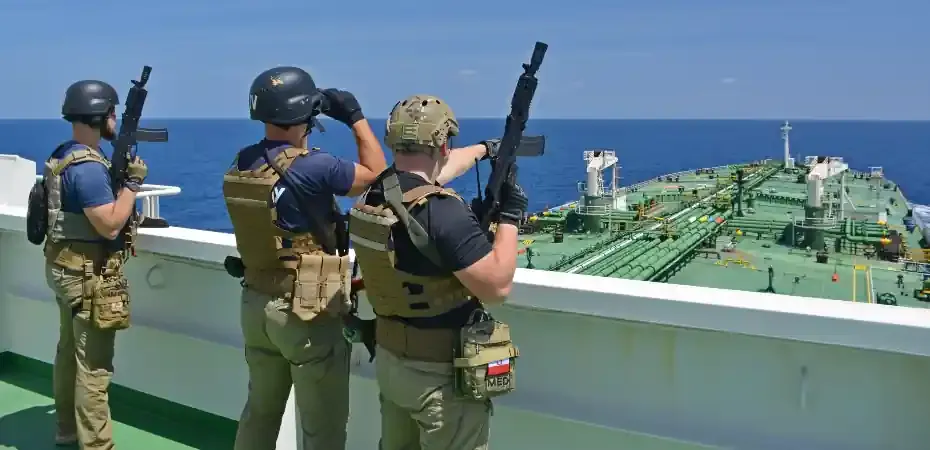
Maritime Security Operative
Overview
The Maritime Security Operator (MSO) course is designed to equip participants with the knowledge and practical skills necessary to provide security in maritime environments, including high-risk areas. This course focuses on threat mitigation, vessel protection, anti-piracy operations, and the legal frameworks governing maritime security operations. It prepares individuals to effectively safeguard vessels, crews, and cargoes against modern maritime threats, including piracy, armed robbery, and terrorism.
Participants will learn both the theoretical and operational aspects of maritime security, ensuring they are well-prepared to operate in complex and dynamic maritime settings.
Duration
10 Days
Training Cost
€ 2500

Objectives
- Understand the global maritime security environment, including current threats such as piracy, terrorism, and smuggling.
- Learn the legal framework for maritime security, including international maritime laws, rules of engagement, and the use of force.
- Develop skills in risk assessment and planning for vessel security operations, including creating and implementing Ship Security Plans (SSP).
- Master shipboard security measures, including perimeter security, access control, and anti-intrusion tactics.
- Gain proficiency in using non-lethal and lethal weapons for the protection of vessels and personnel.
- Learn techniques for detecting, deterring, and defending against maritime threats such as piracy and armed robbery at sea.
- Understand emergency response procedures, including man-overboard drills, fire safety, and vessel evacuation.
- Develop communication skills for coordination with vessel crews, shipping companies, and international naval forces.
Topics
- Overview of the maritime security environment
- Current global maritime threats: piracy, armed robbery, smuggling, terrorism
- Understanding the role of a Maritime Security Operator (MSO)
- Legal frameworks governing maritime security:
- United Nations Convention on the Law of the Sea (UNCLOS)
- International Maritime Organization (IMO) regulations
- International Ship and Port Facility Security (ISPS) Code
- Rules of engagement and use of force at sea
- Conducting risk assessments for maritime operations
- Identifying and evaluating maritime threats (risk factors, regions, routes)
- Developing Ship Security Plans (SSP) and implementing security measures
- Vessel hardening techniques: securing ship access points and installing barriers
- Contingency planning for security breaches and threat response
- Roles and responsibilities of the MSO on board a vessel
- Perimeter security and onboard surveillance techniques
- Access control procedures (identifying, screening, and managing visitors)
- Anti-intrusion tactics for vessel protection
- Conducting security patrols on deck and in sensitive areas of the ship
- Cargo security: preventing tampering, theft, and contraband smuggling
- Overview of modern piracy tactics and techniques
- Understanding piracy threat zones (e.g., Gulf of Aden, Strait of Malacca, Gulf of Guinea)
- Defensive strategies against piracy attacks:
- Vessel evasion and maneuvering techniques
- Use of non-lethal deterrents (water cannons, acoustic devices)
- Boarding prevention methods and counter-boarding operations
- Defensive firearms training for maritime environments:
- Firearms safety and rules of engagement at sea
- Weapon handling in maritime conditions (rifles, shotguns, handguns)
- Marksmanship drills under stress
- Introduction to maritime security equipment:
- Surveillance systems (CCTV, radar, thermal imaging)
- Communications technology for coordinating with international forces
- Understanding the role of maritime tracking systems (AIS, GPS)
- Using security alarms and alert systems effectively
- Vessel lighting strategies for deterrence and defense
- Responding to onboard emergencies: fire, medical emergencies, and environmental hazards
- Man-overboard drills and search-and-rescue operations
- Coordinating with emergency services and naval forces during crisis situations
- Evacuation procedures and lifeboat deployment
- Understanding Post Incident Procedures (PIP): debriefing and reporting
- Vessel escort and convoy operations in high-risk areas
- Tactical boarding and inspection techniques
- Tactical communications in hostile environments (use of radio and hand signals)
- Securing critical infrastructure (offshore platforms, ports, and terminals)
- Counterterrorism strategies for maritime environments
Weapons & Ammo
- Glock 17/19
- AK/M4
- 9 mm: 300 Rds
- 7.62 mm : 300 Rds
Inclusions
- Training
- Certification
- Weapons
- Ammo
- Tactical Gear
- Food & Accommodation
- T-Shirt
- Patch
- Pick & Drop: Airport to Hotel/Hotel to Training Area
- Visa Assistance
Experience
Combined Firearms Course Recommended
Things to Carry
- Tactical Pants
- Tactical Shoes/Boots
- Tactical Eye Protection Glasses
- Tactical Belt
- Tactical Gloves
- Tactical Elbow & Knee Pads
- Clothing Appropriate For Climate And Conditions
Documents to Carry
- Passport
- National ID
